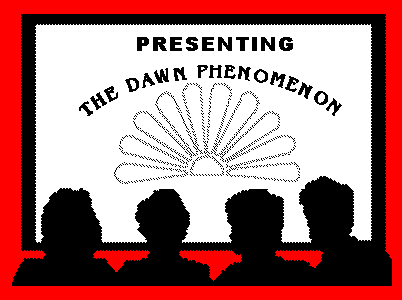Let's explain this in a bit more detail.
Again and again you may find high fasting blood sugar levels (250 mg/dl or even 300 mg/dl [13.9 mmol/l or 16.7 mmol/l]) in the morning. Why does this happen?
There are two possibilities.
1. The hyperglycaemia could be due to a period of hypoglycaemia in the early morning hours between 4 a.m. and 6 a.m.
This is called counter-regulatory hyperglycaemia or posthypoglycaemic hyperglycaemia.
2. Or it could be simply an episode of morning hyperglycaemia without
previous hypoglycaemia.

This morning hyperglycaemia is called the dawn phenomenon.
These episodes of hyperglycaemia are caused by the fact that during the early morning hours
certain hormones which raise the blood sugar level, principally growth hormone,
are secreted quite spontaneously into the blood.
|
Well now, how can I find out what the cause is in my case?
It's important to know, for if it is posthypoglycaemic hyperglycaemia I've got to give less NPH in the evening injection, and if it's the dawn phenomenon I've got to give more.
Splendid! You've grasped the idea exactly.
What you've got to find out is whether there has been a period of hypoglycaemia during the night. Signs pointing to this are disturbed sleep with bad dreams, and waking up next morning tired and washed out.
But the only way of finding out for certain is to determine your blood sugar between 4 a.m. and 6 a.m.

Now you will also understand why it is that you must give your basal rate insulin, your NPH
insulin, as late as possible, preferably at 11 p.m. instead of 10 p.m. The idea is that it should be producing its strongest effect when the dawn phenomenon reaches its peak, namely in the early morning hours between 4 a.m. and 6 a.m.
|



